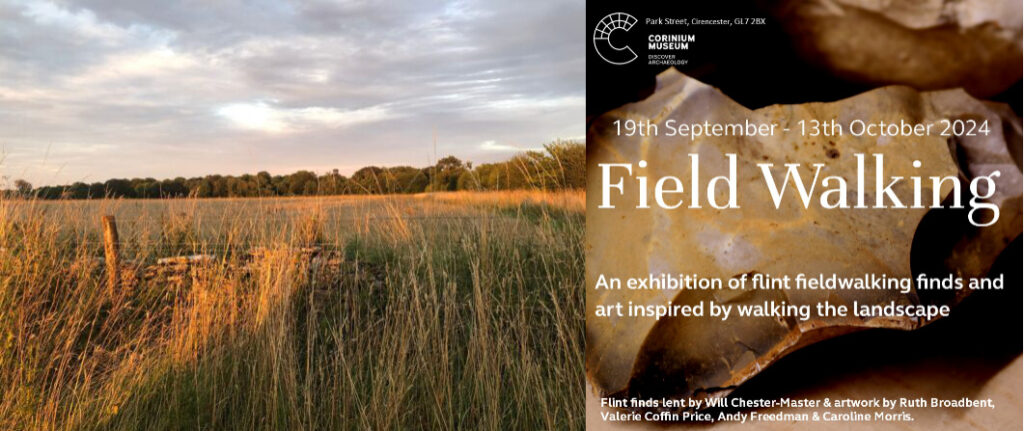
A collaborative project between
Corinium Museum – Abbey Home Farm – Walking the Land.
In 2023, Will Chester-Master, one of the custodians of Abbey Home Farm approached the Corinium museum to display field walking flint finds in the temporary exhibition space; inspired by the success of Art and Archaeology of Belas Knap Long barrow exhibition by Elizabeth Poraj-Wilczynska the year before. The museum was pleased to facilitate a collaboration between Will Chester-Master and Walking the Land artists: Ruth Broadbent, Valerie Coffin Price, Andy Freedman, and Caroline Morris.
The artists collaborated with Will and the landscape of Abbey Home Farm. Inspired by the history, nature, the ethos of the farm, the proposition developed into an exhibition featuring artists’ responses to the landscape from which the flint came. Artworks were displayed alongside part of the farm’s museum of field finds.
Please note if you would like to field walk, permission must be obtained from the landowner prior to field walking.
Corinium Museum
Between 19th September – 20th October 2024 the Corinium Museum hosted an exhibition of fieldwalking finds from Abbey Home Farm and artwork inspired by the landscape. A selection of exhibits from Will Chester-Master’s museum of farm finds were displayed alongside art inspired by walking the fields on the farm .
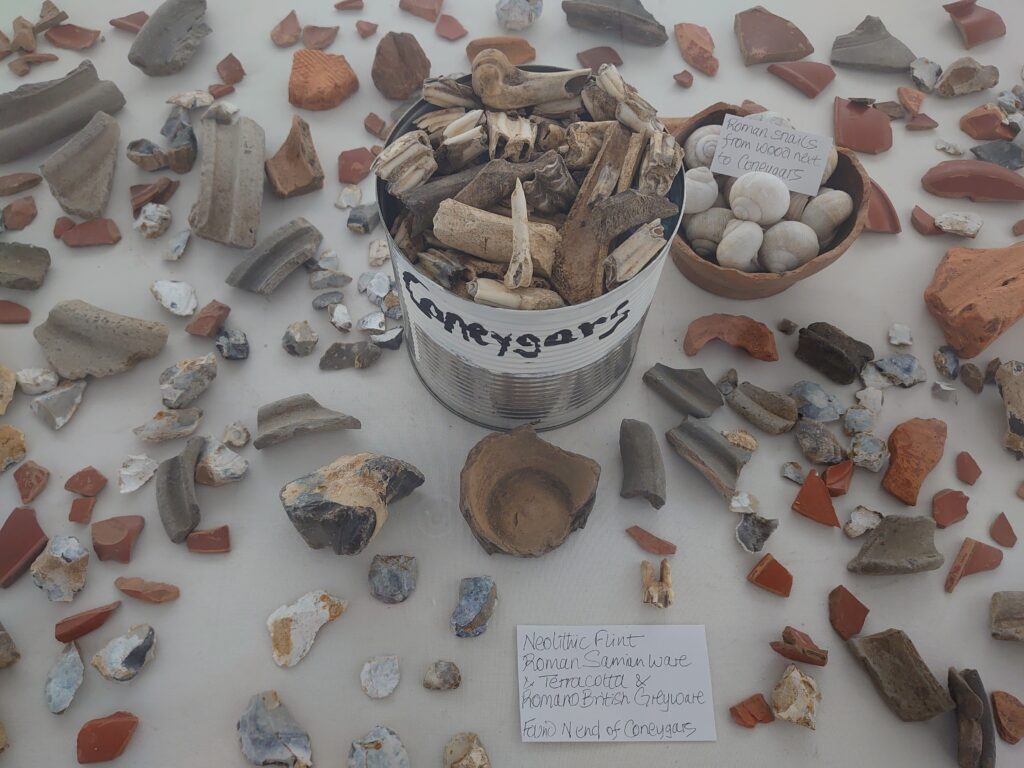
Prehistoric worked flints come up in the plough soils, along with shards of Roman pottery. Way back, this was Abbey land, is crossed by Roman roads, a disused 19th century railway line and was blasted through by a dual carriageway. Will is one of the custodians of a farm which carries traces of many thousands of years of history.
Image showing a selection of exhibited flints and finds found by Will Chester-Master while fieldwalking Abbey Home Farm. Image courtesy of Caroline Morris.
Archaeological research by Tabitha Grist Parker.
Corinium webpage: https://coriniummuseum.org/event/field-walking/
Abbey Home Farm
The land that the Chester-Master’s manage carries the traces of many thousands of years of history.
The flints in this exhibition have come from fields across the farm, and continue to come up in the plough soils. Flints are not naturally found in this area. The flint arrowheads, knives and scrapers found across many of the farm’s fields indicate activity on the land since the Neolithic.
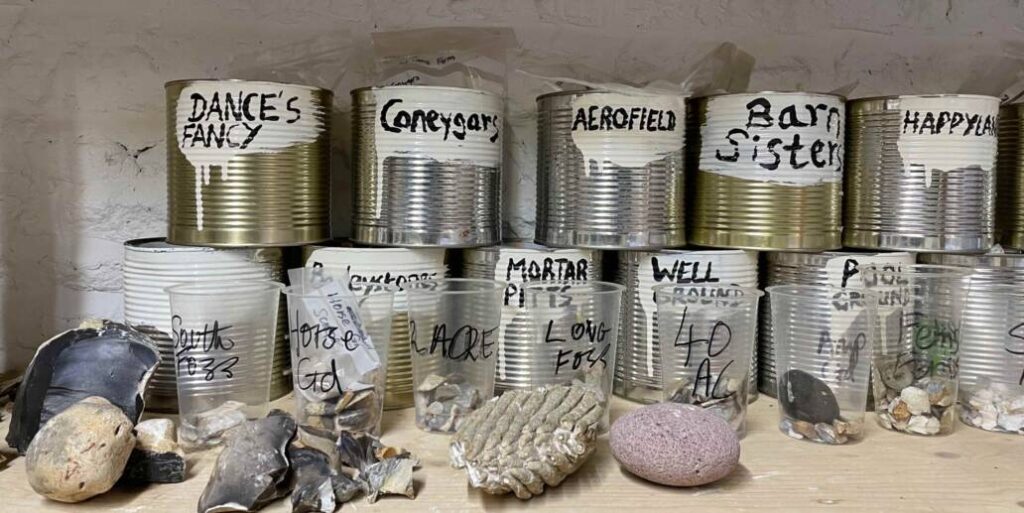
Flints are sorted and stored in cans named with field names where they were found. Image courtesy of Corinium Museum.
Artists Artwork
Ruth Broadbent
GroundLines
72 Groundlines drawings inspired by walking the landscape where many of the flints were found.
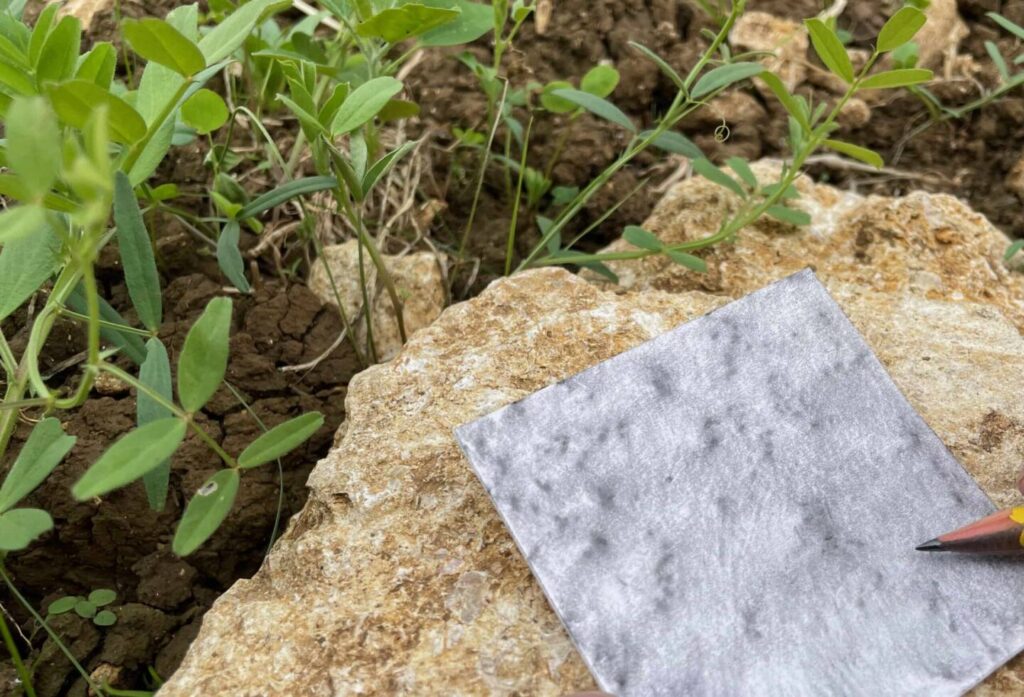
Image of Ruth Broadbent making a Fieldwalking – Groundline drawing (July 2024).
Image courtesy of Ruth Broadbent
72 Groundlines drawings inspired by walking the landscape where a collection of flints have been found. They were made over a few months, each one created in a different place on Abbey Home Farm, ‘mapping’ the fields through walking, pausing to draw, slowly getting to know the land, its stories, its visible and hidden layers. I spent time amongst the labelled tins of flint in the barn, walked the tracks and fields of the farm, and camped there at night. I was able to lose myself for hours wandering from field to field, musing over the various field names from Dancy’s Fancy and Happy Lands, to Barn Sisters and Hitchens Knowle. As I walked the old ways that pass through and alongside the farm, I also imagined the long standing connections to people and places further afield.
Read more at: https://www.ruthbroadbent.com/groundlines/fieldwalking-groundlines
Valerie Coffin Price
Field Fragments
What is archaeology? How do we experience landscapes, now and in the past? What
archaeological traces can be found in maps and place names? These are the question behind
Field Fragments.
Having been drawn to the farm itself through the use of maps, drawings and photographs the
work responds to those liminal drawings created on the land by the architecture of the farm.
Using an archaeological approach to its routes and trackways and to the links hidden in the
landscape, its geology and archaeology, the final drawings explore the fragmentary nature, both
of archaeology and field walking, of memory as well as the apparently random nature of the
fields, their names and finds.

https://axisweb.org/artist/valeriecoffinprice
Andy Freedman
In Britain we know that usually we are standing on land which has been walked on by generations of people going back thousands of years. humans who left very little trace.
I’m fascinated by this sense that as we walk, we are adding to the layers of human activity.
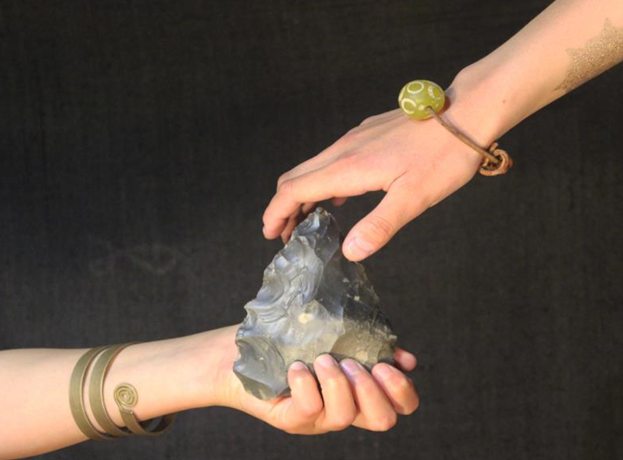
At the same time we live with the legacy of Victorian history and archaeology. This generally regarded people who didn’t leave writing and buildings as ‘primitive’. ‘Civilisation’ required records of a social structure, a legal system and culture which the Victorians could recognise.
Image of Photograph by Andy Freedman. Provided courtesy of Andy Freedman.
Cultures without that legacy were ‘uncivilised’ a description also applied to contemporary people living outside Europe.Yet the outcomes of our field walking illustrate that our ancestors were much more sophisticated than we were led to believe.
Caroline Morris
Topographic Clews
For some time, I have been using darning, patching and repair as a metaphor for landscape history.
For Field Walking I produced two fabric maps of the landscape. The patchwork is based on the modern map, which is a landscape well documented, geo-located, measured and in motion. The tithe map is translucent organdie, stitched with the old hedgerows and roads. Its outlines based on the hand drawn, the estimated, the ghostly remnants of the past laying beneath. If it is laid over its calico sister, it will sometimes match but other times show change.
https://magpieseven.wordpress.com/

